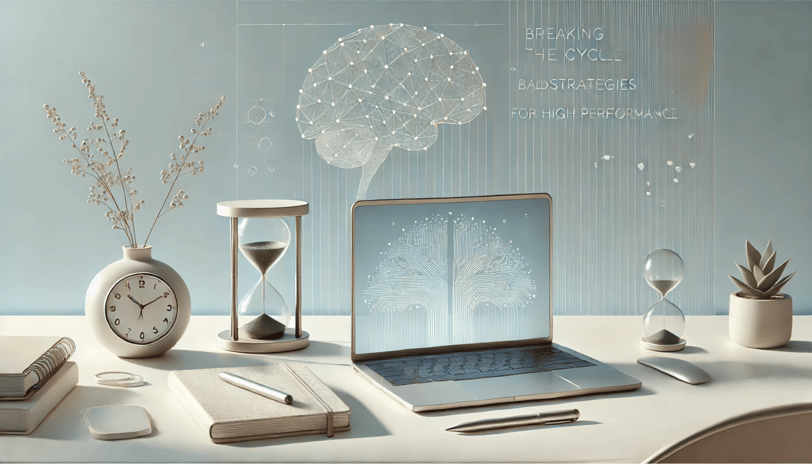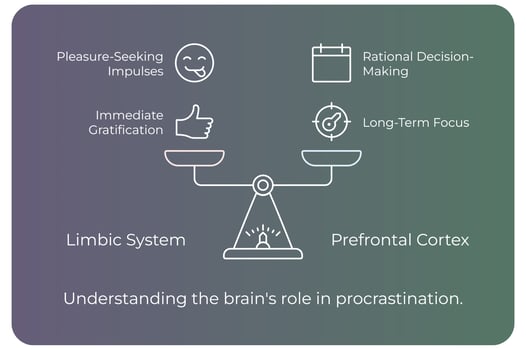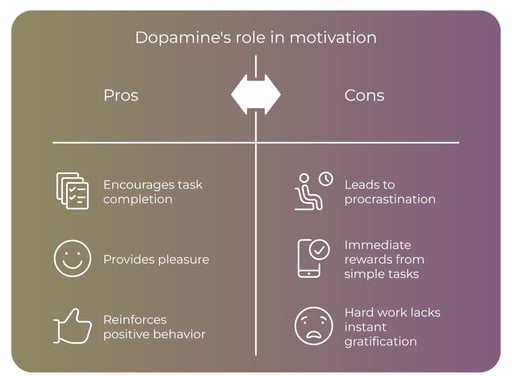Breaking the Cycle of Procrastination: Neuroscience-Backed Strategies for High Performance
Discover neuroscience-backed strategies to overcome procrastination and boost productivity by rewiring your brain. Learn how dopamine, neuroplasticity, and brain training can help you break the cycle for high performance.
PRODUCTIVITY


Procrastination is an issue almost everyone faces at some point. Whether it's putting off an important task until the last minute or feeling overwhelmed by your to-do list, procrastination can be a significant roadblock to success. But what if we told you there are neuroscience-backed strategies that can help you break this cycle and enhance your productivity? By understanding how the brain works when we procrastinate, we can adopt targeted approaches that rewire our habits and push us toward high performance.
In this article, we'll delve into the science of procrastination and provide practical, actionable strategies to help you take control of your time and brainpower.
1. What Happens in the Brain During Procrastination?
When we procrastinate, it isn't just a lack of motivation or poor time management. In fact, procrastination is deeply rooted in the brain's neurobiology. The brain is a complex organ with several competing systems, and when it comes to productivity, two primary regions are involved: the limbic system and the prefrontal cortex. The limbic system, also known as the emotional brain, is responsible for our immediate pleasure-seeking desires and impulses. On the other hand, the prefrontal cortex—the rational, decision-making part of the brain—tries to keep us focused on long-term goals and future rewards. When we procrastinate, the limbic system takes over, seeking immediate gratification (like scrolling through social media or watching videos) instead of allowing the prefrontal cortex to keep us focused on the task at hand. Understanding this conflict is the first step in breaking the procrastination cycle.
Recent studies published in 2023 have shown that procrastination can be seen as a failure of self-regulation, where the limbic system overpowers the prefrontal cortex (Xu et al., 2023). Researchers highlighted that this emotional tug-of-war can be managed through specific brain-training techniques. This book, Limitless Expanded Edition, has actually helped me quite a lot in improving my focus and unlocking greater cognitive potential.


2. The Role of Dopamine and Motivation in High-Performance Tasks
Dopamine, the brain’s “feel-good” neurotransmitter, plays a huge role in how motivated we feel to complete a task. The dopamine reward system is designed to encourage behaviors that provide pleasure and satisfaction. Unfortunately, activities that require hard work often don’t offer immediate rewards, which leads to procrastination. Here’s the science behind it: When we check off smaller, simpler tasks or indulge in pleasurable activities (such as checking social media or playing games), our brain gets a dopamine hit, reinforcing these behaviors. This is why we often procrastinate by doing something that feels "easy" or "fun" rather than tackling more meaningful tasks. The trick is to harness dopamine in ways that align with your goals.
How to Create a Motivation Loop:
Break tasks into micro-goals. Each small accomplishment gives you a burst of dopamine, which in turn fuels further progress.
Reward yourself after completing key milestones. The more you tie the completion of important tasks to rewards, the more likely you are to stay motivated.
Manipulate your environment to reduce distractions. The fewer dopamine-rich alternatives (like phones or social media) you have around, the easier it is to stay focused.
According to my latest discovery, the book Faith Over Fear: How to Adopt a Success Mindset, suggest that setting achievable mini-goals increases dopamine production, which can help reduce procrastination and improve long-term productivity.


3. Proven Techniques to Rewire Your Brain for Productivity
To effectively combat procrastination, you need to rewire your brain. Luckily, the brain is malleable and capable of change through a process known as neuroplasticity. By consistently applying the right techniques, you can train your brain to prioritize long-term goals over short-term distractions. These include memory-enhancing games, neurofeedback, mindfulness practices, and executive function improvement exercises. These approaches target brain regions related to impulse control, attention, and self-regulation, all of which are crucial in managing procrastination.
Cognitive Behavioral Therapy (CBT) Techniques:
Thought Restructuring: When you notice procrastination-related thoughts (e.g., “I’ll never get this done”), challenge them with positive affirmations (“I’ve handled tasks like this before, and I’ll complete this too”).
Exposure Response Prevention (ERP): This involves exposing yourself to the task you’re avoiding, even for short periods. Over time, this reduces anxiety around the task and increases focus.
Brain Training Exercises:
Use apps like Brain.fm or Focus@Will, which use scientifically-designed soundscapes to promote concentration and reduce mental fatigue.
The Pomodoro Technique is a powerful brain-training exercise. By working in 25-minute intervals followed by short breaks, it conditions your brain to stay focused for manageable periods, reducing procrastination.
In 2024, studies demonstrated that using structured work intervals with strategic breaks increases both productivity and the ability to focus (Kim et al., 2022).
Related Read: 10 Micro-Habits That Transformed My Productivity in Just 30 Days


4. Create an "Instant Gratification Buffer"
Procrastination often stems from the brain's desire for instant gratification. Instead of jumping into difficult tasks, we turn to quick pleasures like phone notifications or snacking. To outsmart this urge, you can create what I call an “Instant Gratification Buffer”. This involves intentionally delaying access to distracting activities by building a buffer between you and the reward. For example:
Put your phone in a drawer or another room when you begin work.
Block distracting websites using browser extensions (like StayFocusd or Freedom) for specified periods.
By creating this buffer, you give your brain time to get into a productive flow state before it can fall back on distractions.
Recent findings from 2023 reveal that the mere presence of a smartphone or other immediate distractions can significantly lower attentional performance. By reducing the availability of such distractions, individuals can experience a marked improvement in focus and task completion (Skowronek et al., 2023).


5. How to Build Long-Term Habits by Hacking Your Brain's Reward System
Building lasting productivity habits requires a deliberate focus on the brain’s reward system. Habit formation hinges on the consistency of behaviors, but maintaining that consistency is often where we struggle. By hacking the reward system, you can make this process feel more natural and less forced.
Habit Stacking:
Habit stacking involves pairing a new habit with an existing one. For example, if you always have a coffee in the morning, try starting your workday immediately after your first sip. The brain will start to associate coffee with productivity.
Another tactic is to celebrate small wins. Completing even minor tasks releases dopamine, which reinforces your brain’s desire to continue. Over time, the brain will anticipate this reward, making you more likely to stick with your productivity habits.
In my own journey to build better habits, I found that combining habit stacking with a simple reward system made a significant difference. For instance, by attaching a new habit, like stretching, to an existing routine—right after my morning coffee—and rewarding myself with a few minutes of relaxation, I noticed a marked improvement. After three months, I was able to stick with it consistently, and I believe these strategies played a key role. Drawing inspiration from James Clear’s Atomic Habits, I realized that small changes, when stacked and rewarded, are much more sustainable over time.
Related Read: 7-Day Stress Detox Plan: Scientifically-Backed Ways to Reclaim Your Calm and Well-Being
Final Thoughts
Procrastination is more than just poor time management—it's a neurological challenge. However, by understanding the brain’s mechanisms and implementing science-backed strategies, you can overcome procrastination and boost your productivity. From dopamine management to neuroplasticity techniques, the key to breaking this cycle lies in retraining your brain to focus on long-term rewards over short-term gratification.
Key Takeaways:
Procrastination is a brain-based issue: The battle between the limbic system (emotions) and the prefrontal cortex (logic) is at the root of procrastination.
Leverage dopamine for productivity: By breaking tasks into smaller, manageable parts, you can trigger dopamine release, which helps fuel motivation.
Rewire your brain with neuroplasticity: Techniques like the Pomodoro method and Cognitive Behavioral Therapy (CBT) can retrain your brain to prioritize productivity.
Create an Instant Gratification Buffer: Reducing the availability of distractions allows your brain to enter a productive flow state.
Habit stacking boosts consistency: Pairing new habits with existing ones and rewarding small achievements helps reinforce productive behaviors over time.
Q&As
How long does it take to rewire the brain for productivity?
It takes about 21 to 66 days to build new habits, depending on the complexity of the habit. The key is consistency and reinforcing the behavior with small rewards to boost motivation.
Are there any supplements or foods that boost brain function and reduce procrastination?
Yes. Supplements like omega-3 fatty acids (found in fish oil), ginkgo biloba, and L-theanine have been shown to improve cognitive function and focus. Incorporating these into your diet can help maintain mental clarity and reduce procrastination.
What’s the connection between stress and procrastination?
High stress triggers the limbic system to seek immediate relief, which often results in procrastination. Lowering stress through mindfulness, regular breaks, and physical exercise can significantly reduce the urge to procrastinate.
Can multitasking increase procrastination?
Yes, multitasking often leads to reduced focus, making it easier to procrastinate on important tasks. Switching between multiple tasks can overwhelm your brain and reduce its ability to maintain attention on high-priority activities. Instead, focus on single-tasking to improve productivity.
Related Read: Mindful Multitasking: Can You Really Be Present While Doing It All?
How can I boost productivity when working from home?
Create a structured routine, reduce distractions (like keeping your phone in another room), and designate a specific workspace. Use tools like noise-cancelling headphones or productivity apps like Forest to help stay focused.
Is perfectionism linked to procrastination?
Yes, perfectionism can often lead to procrastination. When you set unrealistically high standards, the fear of not meeting them can cause you to delay starting tasks. Embracing the idea that "done is better than perfect" can help overcome this barrier.


